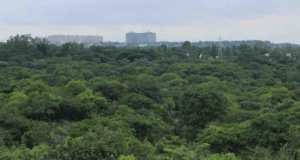Kancha Gachibowli: 7 Incredible Reasons This Urban Forest Is a Hidden Treasure You Must Protect
Kancha Gachibowli, located beside the University of Hyderabad, is one of the city’s last remaining patches of natural forest, offering a rare refuge for both wildlife and humans in an increasingly urbanized landscape. This green haven is home to over 700 species of flowering plants and more than 220 bird species, including the Indian Roller and Oriental Skylark. It also shelters spotted deer, wild boars, porcupines, monitor lizards, and the critically unique Hyderabad Tree Trunk Spider found nowhere else in the world.
Beyond its rich biodiversity, the forest plays a vital role in cooling the city, improving air quality, and recharging groundwater. As development plans threaten this ecosystem, experts warn that its destruction could raise local temperatures and degrade air quality. The forest also serves as an open-air classroom for students and a peaceful space for local residents. Preserving Kancha Gachibowli is not just about saving trees — it’s about protecting a living ecosystem that supports learning, climate resilience, and urban well-being.
In a rapidly expanding city, this forest stands as a powerful symbol of what sustainable coexistence with nature can look like.

Kancha Gachibowli: 7 Incredible Reasons This Urban Forest Is a Hidden Treasure You Must Protect
Imagine finding a lush, vibrant forest alive with chirping birds and tranquil trails—right in the heart of a bustling city. This isn’t a dream. Tucked beside the University of Hyderabad, Kancha Gachibowli is a hidden green paradise that offers a peaceful escape from the city’s noise and chaos. For years, it’s been a sanctuary for students, nature enthusiasts, and locals seeking quiet moments, outdoor learning, or a simple walk among trees. But today, this forest faces a threat: proposed infrastructure projects that could disrupt its delicate ecosystem. Let’s explore why this green oasis matters.
A Green Refuge in a Growing City
Hyderabad is rapidly transforming into a modern metropolis, with skyscrapers and highways replacing open spaces. Yet, Kancha Gachibowli stands strong—a sprawling forested area bordering the university campus. Its wild grasslands, centuries-old trees, and untouched landscapes starkly contrast the concrete jungle around it. This isn’t just a pretty space; it’s a critical ecological zone that supports Hyderabad’s environment. From cooling the air to filtering rainwater, the forest silently works to keep the city healthy.
A Home for Rare and Remarkable Wildlife
Step into Kancha Gachibowli, and you’ll enter a world teeming with life. Over 700 species of plants thrive here, including delicate ground orchids, fragrant wild jasmine, and the bright orange blossoms of the Flame of the Forest tree. But the real magic lies in its wildlife. Birdwatchers flock here to spot 220+ bird species, such as the striking Indian Roller (Telangana’s state bird), the musical Oriental Skylark, and migratory birds that rest here during long journeys.
The forest is also a haven for animals. Spotted deer graze quietly, wild boars rustle through bushes, and shy porcupines emerge at dusk. Look closely, and you might spot monitor lizards patrolling the terrain, non-venomous tree snakes slithering through branches, or toads croaking after monsoon rains. One of its rarest residents is the Hyderabad Tree Trunk Spider—found nowhere else on Earth. Even the endangered Indian Star Tortoise, often targeted by illegal wildlife trade, finds safety here.
Why This Forest Matters to Hyderabad
Beyond its beauty, Kancha Gachibowli plays a vital role in the city’s survival. During Hyderabad’s intense summers, its trees act as a natural air conditioner. Experts warn that losing this green cover could raise temperatures in nearby areas by 1.4°C—a significant spike in a city already battling heatwaves. The forest also prevents soil erosion, recharges groundwater, and filters pollutants from the air—benefits that extend to every Hyderabadi, not just those living nearby.
A Classroom Without Walls
For university students, this forest is a living laboratory. Biology students study its ecosystems, while birdwatching clubs document rare species. Schools organize trips here to teach kids about nature conservation. Locals cherish it as a space for morning walks, photography, or volunteering in clean-up drives. Researchers, too, value Kancha Gachibowli for long-term studies on how urban forests adapt to climate change—a topic few manicured city parks can offer.
The Threat of “Progress”
Despite its importance, the forest’s future is uncertain. Plans for new roads and infrastructure projects risk cutting through its core, threatening habitats and fragmenting the ecosystem. While development is necessary, the question arises: can Hyderabad grow without destroying the very spaces that keep it livable?
Protecting a Shared Legacy
Saving Kancha Gachibowli isn’t just about preserving trees—it’s about safeguarding a space where nature and city life coexist. For a generation increasingly worried about climate change and biodiversity loss, this forest offers a tangible connection to environmental values. It’s a reminder that cities don’t have to be concrete deserts; they can nurture wild spaces that benefit everyone.
Hyderabad stands at a crossroads. Will it prioritize short-term development, or protect a green lung that sustains both people and wildlife? Kancha Gachibowli isn’t just a forest—it’s a symbol of hope, showing that even in a fast-growing city, nature can thrive if we choose to let it.
In a Nutshell:
Biodiversity hotspot: 700+ plants, 220+ birds, and rare animals
Environmental shield: Cools the city, cleans air/water, prevents floods
Community space: Used for education, recreation, and research
Unique species: Home to the Hyderabad Tree Trunk Spider and Indian Star Tortoise
The clock is ticking for this urban wilderness. Its survival depends on recognizing that true progress doesn’t erase nature—it finds ways to grow alongside it.
You must be logged in to post a comment.